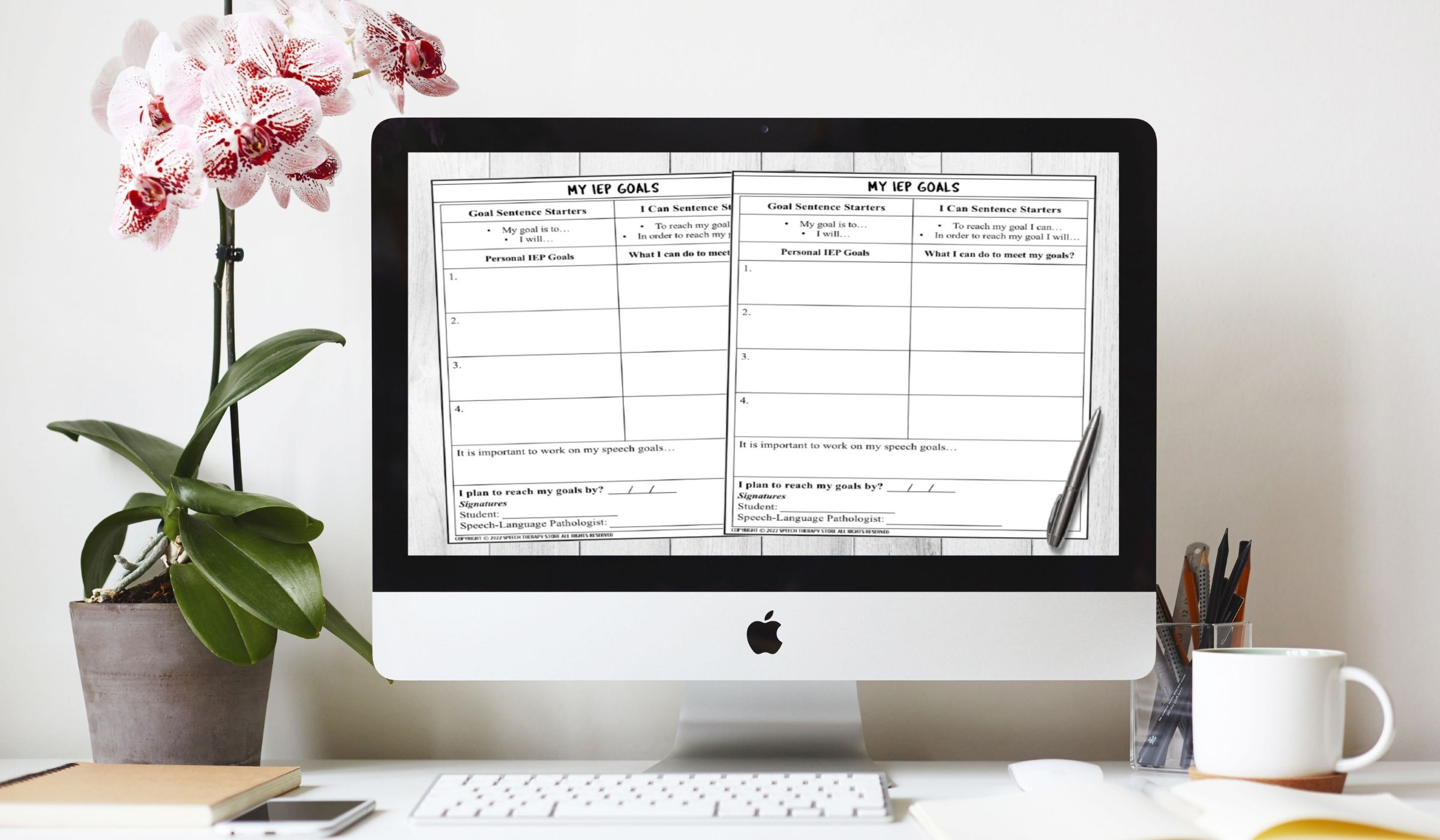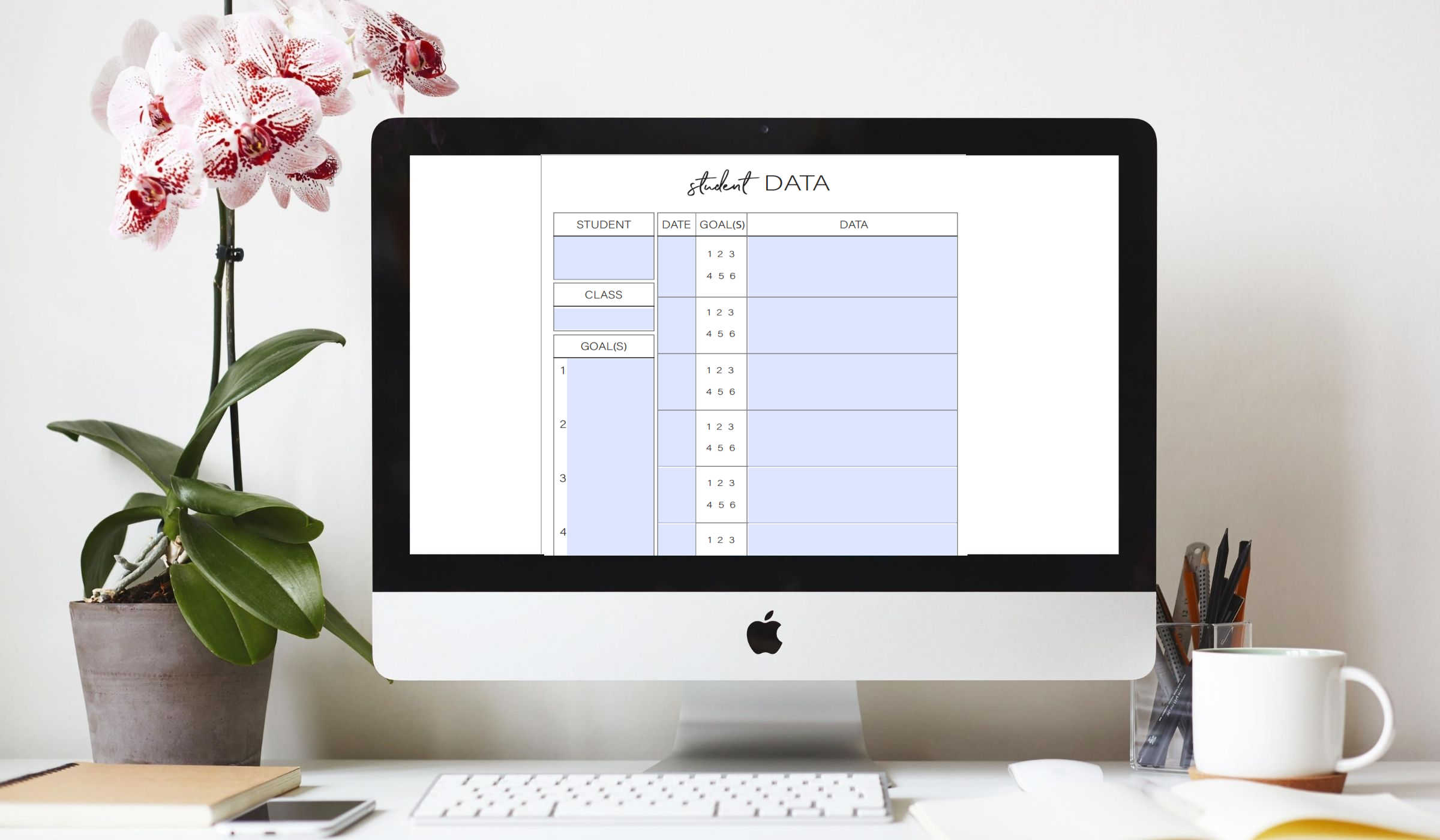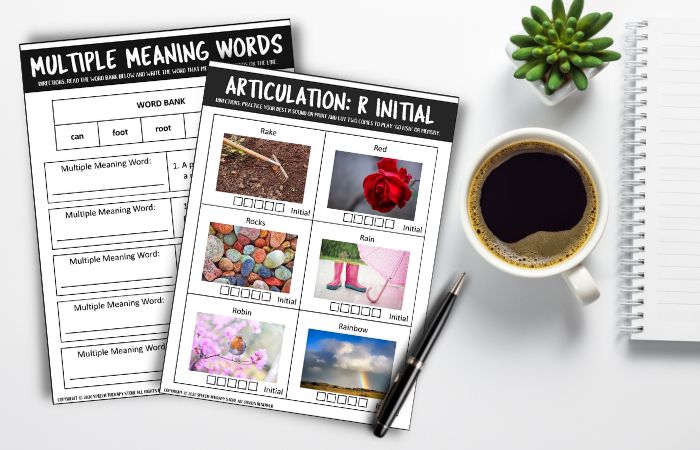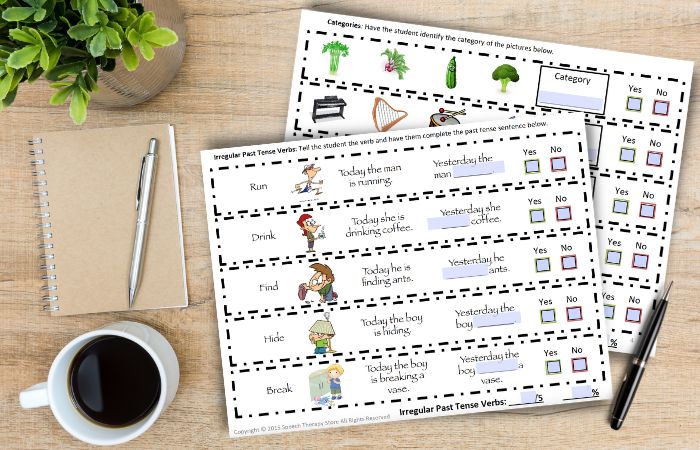“I not know dat”. This is currently one of my 4-year-old twin boys favorite phrases when I teach him something new. I mean can we start with how stinking cute that sentence is?! But back to the point, grammar has a big impact on whether others understand what we are trying to say. That’s why I’ve gathered 21 grammar goals for speech therapy.
My hope is to make your life easier by providing a measurable goal list of good goals for any Speech-Language Pathologist to use and of course adapt to meet the needs of your individual child or students.
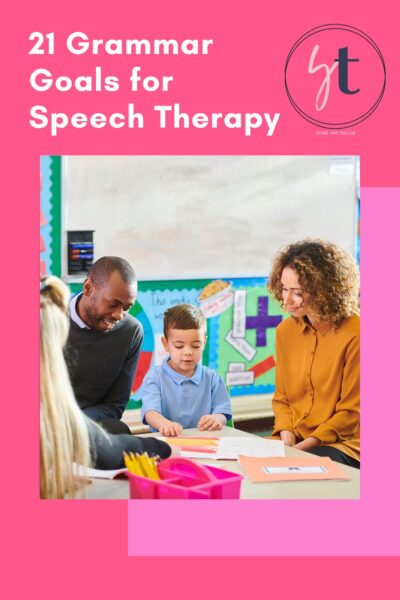
IEP Goals – Expressive Language
1. Articles
Given common objects, a picture, or story, STUDENT will say a complete sentence using articles (i.e., “a”, “an”, “the”, and “some”) with 80% accuracy in 4 out of 5 opportunities.
2. Demonstrative Adjectives
Given an object, picture, or story, STUDENT will say a complete sentence using demonstrative adjectives (i.e., “this”, “that”, “these”, and “those”) with 80% accuracy in 4 out of 5 opportunities.
3. Plural Nouns & Irregular Plurals
Given an object, picture, or story, STUDENT will say a complete sentence using plural nouns (i.e., s, es, and irregular plural forms) with 80% accuracy in 4 out of 5 opportunities.
4. Possessive Nouns
Given an object, picture, or story, STUDENT will say a complete sentence using possessive nouns (i.e., “the girl’s book”) with 80% accuracy in 4 out of 5 opportunities.
5. Subject Pronouns
Given an object, picture, or story, STUDENT will say a complete sentence using subject pronouns (i.e., “I”, “he”, “she”, “you”, “we”, “they”) with 80% accuracy in 4 out of 5 opportunities.
6. Object Pronouns
Given an object, picture, or story, STUDENT will say a complete sentence using object pronouns (i.e., “me”, “him”, “her”, “you”, “us”, “them”) with 80% accuracy in 4 out of 5 opportunities.
7. Possessive Pronouns
Given an object, picture, or story, STUDENT will say a complete sentence using possessive pronouns (i.e., “my”, “mine”, “his”, “her/hers”, “you/yours”, “our/ours”, “their/theirs”) with 80% accuracy in 4 out of 5 opportunities.
8. Reflexive Pronouns
Given an object, picture, or story, STUDENT will say a complete sentence using reflexive pronouns (i.e., “myself”, “himself”, “herself”, “yourself”, “yourselves”, “ourselves”, “themselves”) with 80% accuracy in 4 out of 5 opportunities.
9. Present Verbs
Given an object, picture, or story, STUDENT will say a complete sentence using present progressive verb tense (i.e., “The girl is running”) with 80% accuracy in 4 out of 5 opportunities.
10. Past Verbs
Given an object, picture, or story, STUDENT will say a complete sentence using past progressive verb tense (i.e., “The girl was running”) with 80% accuracy in 4 out of 5 opportunities.
11. Present Tense
Given an object, picture, or story, STUDENT will say a complete sentence using present tense “s” and “es” marker (i.e., “The girl runs”) with 80% accuracy in 4 out of 5 opportunities.
12. Has / Have
Given an object, picture, or story, STUDENT will say a complete sentence using “has”/”have” (i.e., “The girl has a book”) with 80% accuracy in 4 out of 5 opportunities.
13. Regular Past Tense Verbs
Given an object, picture, or story, STUDENT will say a complete sentence using regular past tense (i.e., “The boy waited for the bus.”) with 80% accuracy in 4 out of 5 opportunities.
14. Irregular Past Tense Verbs
Given an object, picture, or story, STUDENT will say a complete sentence using irregular past tense (i.e., “ran”, “drove”, “drank”) with 80% accuracy in 4 out of 5 opportunities.
15. Conjunctions
Given an object, picture, or story, STUDENT will say a complete sentence using conjunctions (i.e., “and”, “or”, “but”, “because”, “if”, “since”) with 80% accuracy in 4 out of 5 opportunities.
16. Future Tense
Given an object, picture, or story, STUDENT will say a complete sentence using future tenses (i.e., “The boy will go to school”) with 80% accuracy in 4 out of 5 opportunities.
17. Negative Sentence Structure
Given an object, picture, or story, STUDENT will say a complete sentence using negative sentence structures (i.e., “will not/won’t”, “does not/doesn’t”) with 80% accuracy in 4 out of 5 opportunities.
18. Yes / No Questions
Given an object, picture, or story, STUDENT will ask yes/no questions (i.e., “Is the boy hurt?”) in a complete sentence with 80% accuracy in 4 out of 5 opportunities.
19. WH Questions
Given an object, picture, or story, STUDENT will ask WH questions (i.e., “What is the girl doing?”) in a complete sentence with 80% accuracy in 4 out of 5 opportunities.
20. Comparatives
Given an object, picture, or story, STUDENT will say a complete sentence using comparatives (i.e., “The kitty is smaller than the tiger”) with 80% accuracy in 4 out of 5 opportunities.
21. Superlatives
Given an object, picture, or story, STUDENT will say a complete sentence using superlatives (i.e., “That is the best cookie.”) with 80% accuracy in 4 out of 5 opportunities.
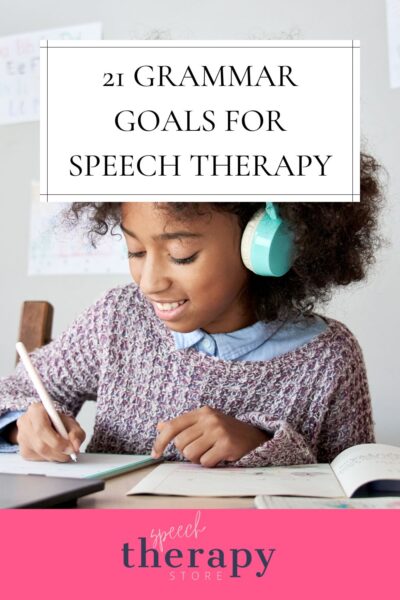
Short Term Goals – Grammar Goals
I know every district and even school setting has different ways it requires the goal writing of their objectives to be written, but typically my district wanted us to reduce either the number required or the percentage of achievement.
Here are a few examples to help get you started.
If we take a sample goal:
“Given an object, picture, or story, STUDENT will say a complete sentence using irregular past tense (i.e., “ran”, “drove”, “drank”) with 80% accuracy over 3 out of 4 consecutive sessions.”
- Reduced Number or Trials Required: The objective might be, “Given an object, picture, or story, STUDENT will say a 2-3 word phrase using an irregular past tense (i.e., “ran”, “drove”, “drank”) with 80% accuracy over 3 out of 4 consecutive sessions.”
- Reduce Percentage of Accuracy: The objective might be, “Given an object, picture, or story, STUDENT will say a complete sentence using irregular past tense (i.e., “ran”, “drove”, “drank”) with 70% accuracy over 3 out of 4 consecutive sessions.”
- Reduce Difficulty of Task: The objective might be, “Given an object, picture, or story, STUDENT will select the correct irregular past tense (i.e., “ran”, “drove”, “drank”) with 80% accuracy over 3 out of 4 consecutive sessions.”
- Reduce Number of Sessions of Accuracy: The objective might be, “Given an object, picture, or story, STUDENT will say a complete sentence using irregular past tense (i.e., “ran”, “drove”, “drank”) with 80% accuracy over 2 out of 4 consecutive sessions.”
(Meaning out of 4 therapy sessions in a row. They identified 3 possible solutions, the 3 consequences of those solutions and then determined the best solution in 2 out of 4 or 50% of the time in order to mark that goal mastered.)
As the Speech Language Pathologist you are the specialist and you know your students specific language impairments and child’s ability best though, so just take the smart goals from above and simplify them into achievable steps for your specific student.
SEE ALSO: IEP Goal Bank Posts

Data Collections
If you’re a speech therapist or a classroom teacher in need of data tracking forms while working on your student’s grammar goals for speech therapy then the first place you might want to check out is my IEP goal data tracking for progress monitoring forms.
Or if you simply want a list of data sheets to choose from then be sure to check out my list of 35 free speech therapy data sheets roundup.
Blog Post Resources
Here are all my blog posts for working on grammar skills that you might also find helpful!
33 Most Common Irregular Plurals Flashcards – Download this first post of free irregular plurals with their real-life photos.
253+ Yes or No Questions for Speech Therapy – Here is a massive resource working on answering yes or no questions.

179+ Wh Questions Free Printable – Grab this freebie to work on answering wh-questions.
197+ Best Wh Questions Speech Therapy Activities – If you have a child or student working on wh-question you’ll also want to check out this list of helpful free resources.
31+ What Questions for Speech Therapy – Have your child or student watch these wordless videos and then answer the “what” question using the interactive quiz with instant feedback.
31 Best Wordless Videos to Work on Answering Questions – Have your student watch these fun animated wordless videos and then answer the included wh-questions.
Nature Themed Bundle – This bundle includes yes/no questions, wh-questions, pronouns, regular past tense verbs, and irregular past tense verbs.
Technology Themed Bundle – This bundle also includes yes/no questions, wh-questions, pronouns, regular past tense verbs, and irregular past tense verbs.
Social Communication Skills – IEP Goals
Do you have students working on other goal areas or language skills? If so, you might want to check out my other goal banks. Here are a few of the goals you would find in my massive 432 iep goal bank:
- Figurative Language
- Language Therapy
- Complex Syntax
- Complex Sentences, Simple Sentences, Compound Sentence
- Relative Clauses
- Mean Length of Utterance
- Context Clues
- Receptive Language
- Articulation Goals
- Word Level, Phrase Level, and Sentence Level (If you have a student working on different speech sounds be sure to check out my target word lists with single word lists plus phrases and sentences for extra practice.)
- Phonological Goals
- Final Consonants
- Fluency Goals
- Slow Rate
- Easy Onset
- Conversational Topic Goals
- Social Language
- Communication Skills
- Pragmatic Language Goals
- Communication Device
Therapy Ideas
I’ve gone ahead and gathered a few activities that you can use in your therapy room for working on your child or student’s grammar speech therapy goals.
Informal Assessments
A great first step would be to complete a formal or informal assessment to find the student’s ability level.
Language Baseline Data Tracking – Grab my baseline data tracking from my tpt store that covers regular/irregular past tense verbs, regular/irregular plurals, yes/no questions, wh-questions, pronouns, copulas, superlatives, plus even more!
Free Informal Screener: 14 Early Developing Morphemes by Teach Speech 365 – includes a quick informal assessment of the 14 early developing grammatical morphemes.
Structured Language Activities
Here are a few different language tasks that speech pathologists can use to work on a specific skill, such as irregular plurals or a prepositional phrase task.
- Building Blocks for Irregular Plurals! By QuirkySpeech is a set of 27 irregular plural nouns. Use this while playing Jenga!
- 33 Most Common Irregular Plurals Flashcards – Download these free irregular plurals with their real-life photos.
- Expanding Sentences-prepositional phrases Digital, no print, boom cards. Free by Winter Sisters is a great digital source designed to help students increase MLU by using engaging sentence strips.
SEE ALSO: 179+ Wh Questions Free Printable
Correct Sentence
Have your students use their appropriate grammar skills to correct the sentences in the following activities.
- School Correct the Sentence – Grammar Skill Builder – Digital Boom Cards by Miss B SLP is a highly rated set of boom cards with a focus on correcting grammatical errors in sentences. This deck has a fun school theme.
- FREEBIE!! “Fix ‘Em Up” No Prep Sentences for Students to Edit and Correct! By Loving Life with Little Learners is a great set of no prep printables to help students practice correcting capitalization, punctuation, spelling and basic grammar.
Middle School
Here are a few grammar language intervention lessons for older students in the school setting.
- FREE Month-Long Daily Grammar Practice | 6th Grade Grammar Spiral Review By Performing for Education is a great set of daily grammar practice for middle schoolers! This is simple and ready to go!
- Apple Themed Speech Therapy Vocabulary and Grammar Worksheets Freebie by Mrs. A’s Speech Therapy Room is a product that helps students address multiple semantic and syntactic articulation skills. These are great for older students!
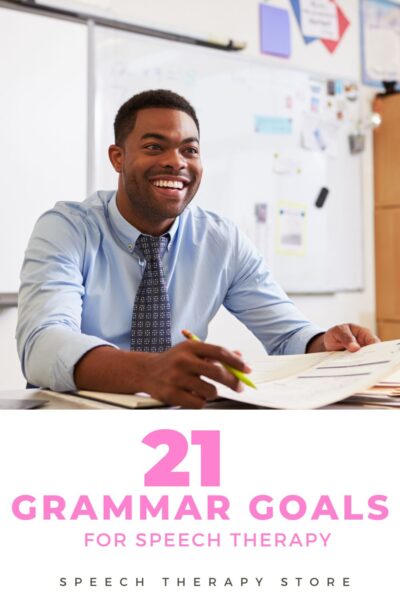
Early Language
If you’re working with young children and have less time to therapy plan here are a few resources you might find helpful.
- Grammar Camp Pronoun Freebie by The Speech Attic is an interactive and fun packet that reviews pronouns. This has a camping theme that students love!
- FREE Verbs Worksheets – grammar activities for first grade and second grade by Keeping my Kinders Busy is a grammar freebie created for k-2. The engaging packet review Verbs!
- Conjunctions | 1st Grade Grammar | Mini Lesson by First Grade Buddies is a favorite! Use matching flashcards and a worksheet to work on conjunctions.
- Conjunctions FREEBIE – First and second grade grammar – compound sentences by Keeping my Kinders Busy is a fun and engaging activity for early elementary learners to start practicing conjunctions!
Short Story
Here are some short stories that you can use to work on your child’s grammar skills within a structured activity.
- Past Tense Verb Story Freebie by Travis Teacher is a great activity that helps students practice their understanding of past tense verbs. This includes 3 writing and matching worksheets!
- Spring Language Packet: Bunnies and Carrots by Peachie Speechie is an amazing spring themed packet that focuses on comprehension, plurals, adjectives etc! This is a highly rated freebie for early elementary students.
- Winter Language Freebie By Speech Tree Co is a fun, no prep packet with winter themed language activities! This packet includes short stories, comprehension, sequencing, Wh Questions, as well as winter verbs and winter vocabulary.
SEE ALSO: 21 Best Reinforcement Games for Speech Therapy
Graphic Organizers
Grab these graphic organizers to provide your child or students with visual prompts when working on their grammar skills.
- Sentence Builders: Leveled Graphic Organizers FREEBIE by Thompson’s Teachings is a great freebie packet that includes different levels and versions of sentence building graphic organizers.
- Compound Sentence Graphic Organizer by Kelly Benefield is a great teaching tool. This is a great graphic organizer to use to evaluate your students’ understanding of compound sentences.
- Using and Not Confusing the Apostrophe and S by Grammar and More Store is a clear and simple graphic organizer for students to use when learning the appropriate use of the apostrophe s. It covers contractions, possessives and plurals.
- Plural Noun Graphic Organizer by PrettyFabulousInFirst can be used both as a graphic organizer for plural nouns or as a scavenger hunt sheet to find examples of plural nouns. Easy to print and use and will fit into a composition notebook.
In Conclusion: Grammar Goals Speech Therapy
I hope you found this list of grammar goals for speech therapy to be helpful along with the resources!
Want Even More Grammar for Speech Therapy?
- 917+ Best Free Boom Cards for Speech Therapy
- 31 Best Wordless Videos to Teach Problem Solving
- 3 Most Common Irregular Plurals Flashcards
- 253+ Yes or No Questions for Speech Therapy
- 179+ Wh Questions Free Printable
Want the Best of the Bests?
Be sure to check out our most popular posts below!

